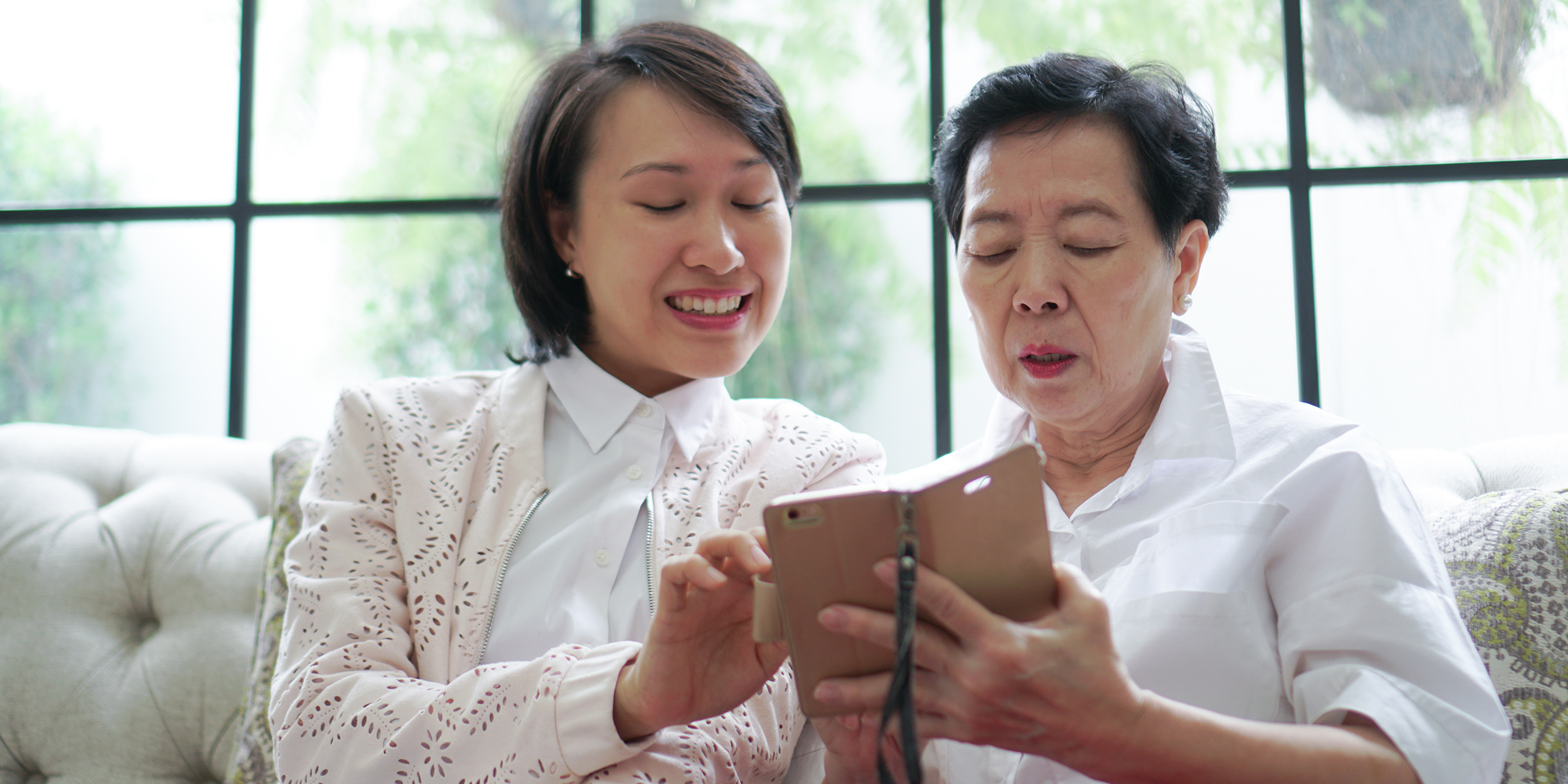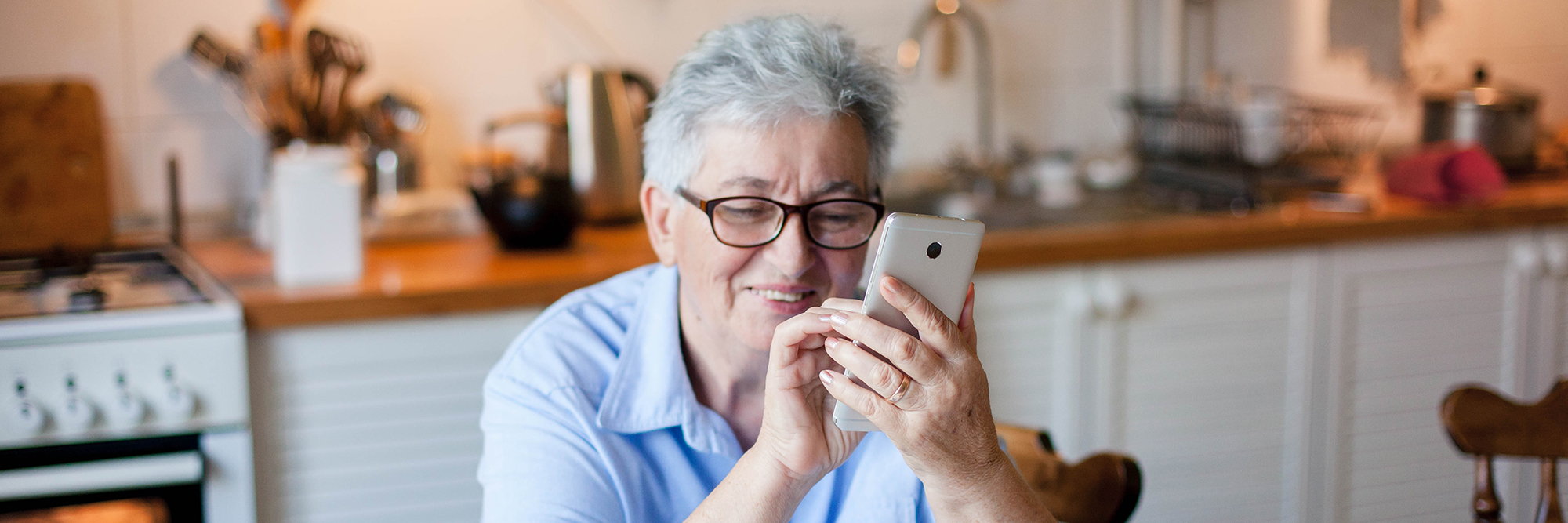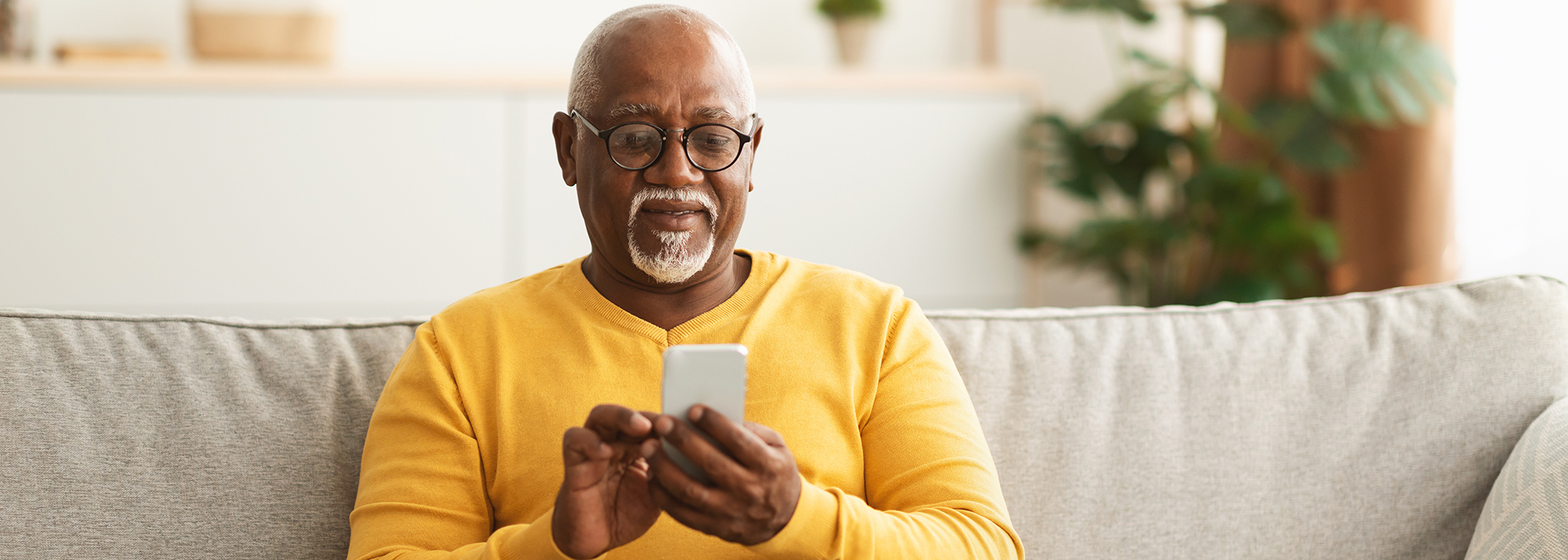What to look for in a smart device for a grandparent or parent
Do you need to know what to look for in a smart device suitable for a senior? Read our guide to learn about important features and how to optimally configure smartphones for older users.
08 November 2023
Over the last couple of years many of us have realised technology can be a lifeline when it comes to getting things done – like being able to order your groceries online, pay your bills at the touch of a button, and see the faces of loved ones halfway around the world on a video call.
Not everyone was able to stay connected though, and many elderly people found themselves incredibly isolated during lockdown. It wasn’t easy to get technology into the hands of our most vulnerable loved ones either with restrictions in place.
Fortunately, with things now getting back to ‘normal’ it’s easier to help those who might struggle to choose an easy to use device to help them stay connected, gain some digital confidence and maintain their independence using technology.
We’ve written this blog with the help from the team at Easology. They’re passionate about making technology easy-to- use, believing that everyone can and should have the latest technology. Working with Samsung, they’ve developed an easy-to-use interface that still allows access to the same functionality that Samsung offer in their tablets. So now, for all of us that can benefit from easy, easy does not need to mean less!

Helping someone older get started with a device
Not all grandparents need help choosing a simple to use device, as many of our older generation were at the forefront of the digital revolution. We know that not all grandparents struggle with technology, and that they’re not all elderly, but there are certain things that older people might find tricky.
Smart devices are a great way to help digital beginners, especially the older generation, get used to technology. There are lots of options available including specially designed, easy to use devices. There are also lots of accessibility features available that comes as standard on many modern smartphones or tablets too.
If you’re trying to help someone get started with a device you might want some answers ready at your fingertips. This blog has been designed to help you to support them get up and running.
What is an easy-to-use device?
An easy-to-use smartphone or tablet is one that the user finds easy. This could vary from person to person depending on the things they find tricky. For instance, a smartphone with a large screen could be better for someone with eyesight issues, and a keypad with spaced out buttons can make typing the right numbers and letters more comfortable for those with dexterity issues.
You could consider choosing a tablet instead of a phone. Being larger than a smartphone can make it easier to use for some, but could be too heavy or awkward to hold for others.
Whatever your age, you’re never too old to start using technology, and a smartphone or tablet can be a great way to get online. There’s a wide range of smartphones or tablets designed for older people which take into consideration some of the issues older people can face, but did you know that many popular standard devices come with helpful accessibility features to make them easier to use too?

Features to look for in smart device for seniors
Most smartphones and tablets are easy to customise. Your home screen, shortcuts and downloaded apps, are probably quite different to the things your parents or grandparents might want on their device.
When choosing a device for yourself, or helping someone else to choose one, it’s a good idea to think about what you’ll need the device to be able to do, such as:
- Online shopping
- Banking online or using an app
- Taking photos
- Making video calls
- Using social media
- Sending text messages or using messaging apps
- Making and receiving phone calls
Finding out what’s important for them, can help with choosing what phone will be suitable for their needs, and how to personalise their device so that the functions and apps they’ll use regularly are in the best place.

Easology conducted extensive research to find out the biggest issues older people have when using handheld smart devices. Below are the key findings and show how perceived minor challenges for the user can quickly make a smart device difficult or even impossible to use:
- Information layouts and menu choices can be confusing and counterintuitive
- App icons can be too small, with small pressing areas making selection difficult
- Text size is often too small to read
- Navigating screen gestures (such as pinch and expand gestures for magnification) can be difficult for anyone with limited dexterity
- Accidental changes in device settings can ‘throw the user’, causing confusion (this often happens on Android devices where the ‘Notifications’ pull-down menu has been accessed by accident and functions selected or de-selected)
- Accidental deletion or movement of apps can cause annoyance or at worst, prevent user access to needed apps and functions
- The settings menu on our device is where most of us personalize our user experience. However, for many, finding what you need in the device settings menu can be a minefield
- Often inferior hardware quality results in a sub-optimal experience for the user, such as low screen & image clarity, poor audio loudness & quality or a battery that does not last all day
Lastly, a common theme that emerged in Easology’s research was that older users felt that technology was not always designed with their needs in mind. This not only covered usability issues as discussed above, but also the lack in provision of features that an older user may find beneficial, for example, enhanced security features or SOS capabilities.
What might they need?
- Size and weight of the device – it needs to be comfortable to suit the user’s needs
- Simple user interface with intuitive navigation, and the ability to customise to suit specific needs
- Clearly labelled buttons that aren’t too small
- Large screen, or easy option to enlarge text
- Hearing aid compatibility - coupling audio from the smartphone directly to hearing aids
- Talking keys facility which reads out telephone numbers as they’re entered
- SOS emergency button to alert designated people when the button is pressed
- GPS tracking - allows relatives or carers to keep track of where the user is
- Call blocking capability
- Voice typing – instead of typing, you might be able to use speech-to-text tools
- Superior screen and audio quality, along with an all-day battery and decent a storage level
Not all devices provide all of these capabilities, so it’s really important to determine what the most important feature are before spending any money. You might also need to take into consideration the need for any additional accessories for the device, such as a holder or a stand depending on how they might use it.
Other things to consider:
- Coverage: do a quick check to see if the mobile provider has coverage where they live, you can do this on most comparison websites when looking to choose a new mobile phone
- WiFi: do they have internet access in their home? If not, they’ll need to choose a deal that gives them access to data and the ability to use the internet
- Costs: how much will they be using their smartphone? This can help them to decide whether to have a monthly or pay as you go tariff.
How to setup a smartphone for a senior
Once you’ve made a decision on which phone is going to be the best fit, you can usually find the user guide in the box, or more often than not – online. Once you’ve checked the manual, it’s worth having a look for online video tutorials for getting started with the device you’ve chosen, as they can be really helpful too. Type the name or model number of your new device followed by ‘getting started tutorial’ into your search engine or browser.

Most devices have some accessibility settings that can be switched on to help anyone wanting to make their device easier to use. Not only can these be helpful for older people, but they can also help anyone who has dexterity issues, hearing difficulties, or sight impairments.
You might be able to change your text size, adjust brightness levels, and set up voice controls.
Visit the accessibility pages or user guides for the manufacturer of your device to find out more, here are some to get you started:
AbilityNet have created pages on their website called MyComputerMyWay that gives you guidance for how you can adapt the device you're using for your needs. Just type in the Operating System your device is using to see what your options are.
When helping someone else get their phone set up, some of the most helpful things to start with include:
- Find my iPhone for Apple users, or Find my Device for Android. This can help you find their smartphone if it gets lost
- Help them to create a lock screen passcode
- Add shortcuts of the tools they’ll use the most to the home screen
- Increase the font size across all areas of the device
- Establish appropriate ringtones and notifications
- Setup their contacts list
- Setup their email account
- Add emergency information including emergency contacts and medical information
- Uninstall or disable any unnecessary apps
- Address security by setting up two factor authentication, installing appropriate malware protection and providing the user with guidance.
This Digital Wings module can help explain how to complete many of these topics in depth.
If you think your parent or grandparent may benefit from a tablet rather than a smartphone, Easology have collaborated with Samsung to enable the hugely popular Samsung Galaxy Tab A8 to be older person friendly.
The Easology edition of the tablet comes with a unique interface that is designed specially with an older user in mind, incorporating the elements discussed above such as large icons, large text, intuitive navigation and much more. As well as being easier-to-use, the tablet is rich in function and features and may be right up your parents or grandparents street!

Find out more at easology.net/Barclays
Want to learn more? Register for Digital Wings
Hopefully with a little help, your grandparent is now ready to get started with their shiny new device. Why not get them registered for Digital Wings to learn even more digital skills like staying safe online, how to get started with social media, and how to use their phone to take great pictures. We’d love to know how they’re getting on too!
This document is an independent publication and is neither affiliated with, nor authorised, sponsored, or approved by the companies mentioned. All trademarks are the property of their respective owners. There are other services available and Barclays does not specifically endorse or recommend the use of the services mentioned in this document.
More articles
Staying active and connected in the digital age
25 June 2024
Discover how autum, the app for over 50s, aims to transform ageing. With simple lifestyle changes, it can help you live healthier for longer.
Advanced fee and Investment scams
30 April 2024
In our first fraud and scams awareness blog, we’ll be focusing on two scams which were very prominent in 2023, investment and advance fee scams.

